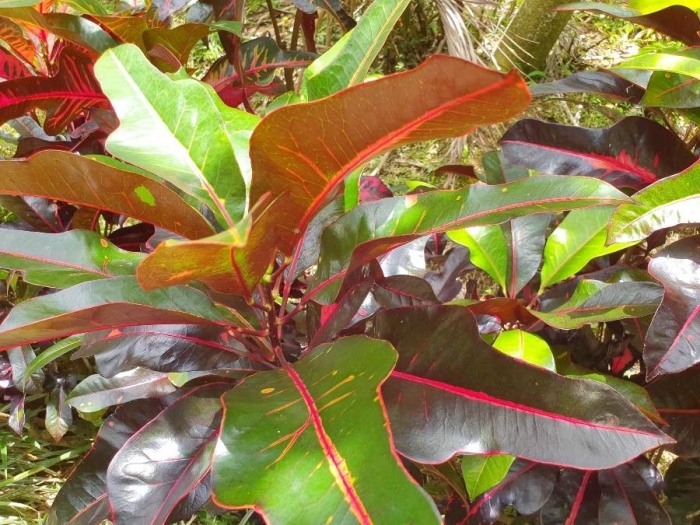Croton
(Codiaeum variegatum)
Croton (Codiaeum variegatum)
/
/

Suzelle HUTEAU
CC BY-SA 4.0
Image By:
Suzelle HUTEAU
Recorded By:
Copyright:
CC BY-SA 4.0
Copyright Notice:
Photo by: Suzelle HUTEAU | License Type: CC BY-SA 4.0 | License URL: https://creativecommons.org/licenses/by-sa/4.0/ | Attribution: Suzelle HUTEAU (cc-by-sa) | Rights Holder: Suzelle HUTEAU | Publisher: PlantNet | Date Created: 2019-07-20T11:37:36Z | Title: Codiaeum variegatum (L.) Rumph. ex A.Juss.: leaf | Notes: |






















































































Estimated Native Range
Summary
Codiaeum variegatum, commonly known as Croton, is an evergreen shrub native to tropical forests, open woodlands, and scrub areas from in Malaysia, Indonesia, the Philippines, and Norwestern Austrailia. It can grow up to 3 meters (9.8 feet) tall in its natural habitat but is typically smaller in cultivation, reaching 2-6 feet in both height and width. The Croton is celebrated for its large, thick, leathery, and shiny evergreen leaves that are alternately arranged, measuring 5–30 cm (2.0–11.8 in) long and 0.5–8 cm (0.20–3.15 in) broad. The foliage comes in a variety of shapes and colors, often featuring vibrant combinations of green, yellow, red, orange, and even purple, which can be speckled, veined, or striped.
Crotons are valued for their striking foliage and are commonly used as hedges, potted patio specimens, and houseplants in colder climates. They produce inconspicuous white flowers in the summer, but the plant is primarily grown for its colorful leaves. Crotons prefer part shade but can tolerate full sun in cooler climates. They require medium amounts of water and well-draining soil. In regions where temperatures fall below 10° to 13°C (50° to 55°F) in winter, Crotons should be grown indoors or in greenhouses to prevent cold damage. They are relatively easy to maintain but can be susceptible to spider mites and mealybugs if grown in dry indoor environments.CC BY-SA 4.0
Crotons are valued for their striking foliage and are commonly used as hedges, potted patio specimens, and houseplants in colder climates. They produce inconspicuous white flowers in the summer, but the plant is primarily grown for its colorful leaves. Crotons prefer part shade but can tolerate full sun in cooler climates. They require medium amounts of water and well-draining soil. In regions where temperatures fall below 10° to 13°C (50° to 55°F) in winter, Crotons should be grown indoors or in greenhouses to prevent cold damage. They are relatively easy to maintain but can be susceptible to spider mites and mealybugs if grown in dry indoor environments.CC BY-SA 4.0
Plant Description
- Plant Type: Shrub
- Height: 2-6 feet
- Width: 2-6 feet
- Growth Rate: Slow
- Flower Color: White
- Flowering Season: Summer
- Leaf Retention: Evergreen
Growth Requirements
- Sun: Part Shade
- Water: Medium
- Drainage: Fast
Common Uses
Potted Plant
Natural Habitat
native to tropical forests, open woodlands, and scrub areas from in Malaysia, Indonesia, the Philippines, and Norwestern Austrailia
Other Names
Common Names: Fire Croton , Variegated Croton
Scientific Names: Codiaeum variegatum , Croton ovalifolius , Croton variegatus , Codiaeum interruptum , Croton irregularis , Codiaeum angustifolium , Codiaeum chrysosticton , Codiaeum crispum , Codiaeum taeniosum , Codiaeum variegatum subsp. genuinum
GBIF Accepted Name: Codiaeum variegatum (L.) Rumph. ex A.Juss.